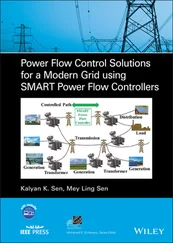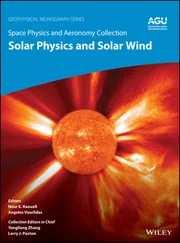Rajiv K. Varma - Smart Solar PV Inverters with Advanced Grid Support Functionalities
Здесь есть возможность читать онлайн «Rajiv K. Varma - Smart Solar PV Inverters with Advanced Grid Support Functionalities» — ознакомительный отрывок электронной книги совершенно бесплатно, а после прочтения отрывка купить полную версию. В некоторых случаях можно слушать аудио, скачать через торрент в формате fb2 и присутствует краткое содержание. Жанр: unrecognised, на английском языке. Описание произведения, (предисловие) а так же отзывы посетителей доступны на портале библиотеки ЛибКат.
- Название:Smart Solar PV Inverters with Advanced Grid Support Functionalities
- Автор:
- Жанр:
- Год:неизвестен
- ISBN:нет данных
- Рейтинг книги:3 / 5. Голосов: 1
-
Избранное:Добавить в избранное
- Отзывы:
-
Ваша оценка:
- 60
- 1
- 2
- 3
- 4
- 5
Smart Solar PV Inverters with Advanced Grid Support Functionalities: краткое содержание, описание и аннотация
Предлагаем к чтению аннотацию, описание, краткое содержание или предисловие (зависит от того, что написал сам автор книги «Smart Solar PV Inverters with Advanced Grid Support Functionalities»). Если вы не нашли необходимую информацию о книге — напишите в комментариях, мы постараемся отыскать её.
Smart Solar PV Inverters with Advanced Grid Support Functionalities
Smart Solar PV Inverters with Advanced Grid Support Functionalities’
Smart Solar PV Inverters with Advanced Grid Support Functionalities — читать онлайн ознакомительный отрывок
Ниже представлен текст книги, разбитый по страницам. Система сохранения места последней прочитанной страницы, позволяет с удобством читать онлайн бесплатно книгу «Smart Solar PV Inverters with Advanced Grid Support Functionalities», без необходимости каждый раз заново искать на чём Вы остановились. Поставьте закладку, и сможете в любой момент перейти на страницу, на которой закончили чтение.
Интервал:
Закладка:
Solar PV systems are based on inverters which have traditionally provided only active power generation from solar energy. Power electronics however allows several additional capabilities to be realized from the same inverters which can be of tremendous benefit in enhancing the stability and reliability of power systems. Efforts have been ongoing worldwide to develop such “advanced” or “smart” functionalities on solar PV inverters. Such inverters have been termed as “advanced inverters” or more commonly as “smart inverters.” Smart inverter functions have been shown to not only mitigate the problems of integration of solar systems themselves but also to alleviate challenges in power systems caused by other sources, such as disturbance events. The developments of smart inverter functionalities have outpaced the Standards responsible for integrating solar PV systems in the grid. The interest and engagement of academics, utilities, system planners, regulators, operators, and manufacturers in the development of the smart inverter technologies is very high.
A wealth of literature has been published over the last two decades describing the controls, simulation studies, laboratory implementations and operating experiences of various functionalities of smart inverters, which continues to grow every day at a very rapid pace. Unfortunately, this invaluable literature is scattered and not available in a comprehensive form.
In 2008, the province of Ontario in Canada undertook a major initiative to develop innovative technologies for integrating solar PV systems at a large scale in transmission and distribution systems. The author of this book was privileged to be selected to lead three highly funded ($8.2 Million) multi‐university multi‐disciplinary multi‐utility research grants in Ontario to achieve this objective. During this period, the author developed a new patented technology of utilizing solar PV systems in the night and day as STATic Synchronous COMpensator (STATCOM), naming it PV‐STATCOM, for providing various grid support functionalities which are typically provided by Flexible AC Transmission System (FACTS).
The author was also fortunate to be the team‐lead for the first‐time delivery of the IEEE Tutorial on “Smart Inverters” with leading experts from EPRI, NREL, National Grid, Southern California Edison, Enphase Energy, and First Solar. This Tutorial was delivered with great success for four consecutive years in IEEE Power & Energy Society (PES) Conferences. This also provided the author a great learning experience of different perspectives of smart inverters. The author also presented several panels sessions in IEEE PES General Meetings, and invited lectures, courses and workshops on smart inverters in different countries.
All the above provided the motivation to compile and organize, even though on a minute scale, the enormously rich and vastly distributed literature on smart inverters in the form of a book. The author is very grateful to the immense knowledge contributed by researchers worldwide, and leading organizations such as IEEE, EPRI, NREL, NERC, WECC, LBNL, CAISO, CIGRE, IEA PVPS Task 14 Group, to name only a few, from whose knowledge and contributions this book has greatly benefited.
This book is organized into nine chapters.
Chapter 1presents the concepts of reactive power and active power control, which form the basis of smart inverter functions. The impact of such controls on system voltage and frequency are explained. Different challenges of high solar PV penetration in transmission and distribution systems are briefly described. The evolution of smart inverter technology is then presented.
Chapter 2presents different smart inverter functions for both reactive power and active power based voltage control. The voltage and frequency ride through functions are explained and their implementation in different Standards such as IEEE Standard 1547‐2018 and NERC’s Standard PRC 024‐3 are described. Smart inverter functions for battery energy storage systems are further elucidated. The prioritization of different smart inverter functions are discussed. Emerging smart inverter functions are then introduced.
Chapter 3presents the basic concepts of active and reactive power flow in a smart inverter system. The operating principles and models of different subsystems in the power circuit and control circuit of a smart PV inverter system are described. The implementation methodology of different smart inverter controls is explained with smart inverter voltage controller as an example. The principle of achieving a decoupled control of active power and reactive power is presented. The modeling needs of different smart inverter controllers are discussed.
Chapter 4presents the basic concepts of FACTS technology and two of its main‐shunt connected member Controllers – the Static Var Compensator (SVC) and STATCOM. The focus of this Chapter is to present a new technology developed by this book’s author, of utilizing PV solar farms both during nighttime when solar farms are typically idle and during any time of system need during daytime as a STATCOM, named PV‐STATCOM. The different nighttime and daytime operating modes of the PV‐STATCOM are illustrated. The cost of transforming an existing solar PV system into PV‐STATCOM as well as its operating costs are analyzed. Subsequently, the potential of PV‐STATCOM technology in providing various benefits in transmission and distribution systems, is elucidated.
Chapter 5describes different night and day applications of PV‐STATCOM technology for providing various grid support functions related to distribution systems, with case studies. These include dynamic voltage control, enhancing connectivity of PV solar farms, increasing connectivity of neighboring wind farms, and stabilization of critical motors. These are the functions for which typically SVCs or STATCOMs are employed, which are quite expensive.
Chapter 6presents different night and day grid support functions provided by PV‐STATCOM in transmission systems. These comprise improving power transfer capacity in transmission lines, damping of power oscillations and alleviation of Fault Induced Delayed Voltage Recovery (FIDVR). These functionalities are provided by reactive power modulation at night and by a combination of active and reactive power modulation during daytime. PV‐STATCOM applications are also presented for mitigation of subsynchronous oscillations in synchronous generators and induction generator based wind farms connected to series compensated transmission lines. A unique PV‐STATCOM functionality of simultaneously providing fast frequency response and power oscillation damping is also described with a case study.
Chapter 7explains the concept of hosting capacity for solar PV systems and its enhancement in distribution networks. Different non smart inverter based methods for increasing hosting capacity are presented. The characteristics of different smart inverter functions and their effectiveness in improving hosting capacity are discussed. The methodologies and guidelines for selecting the settings of different smart inverter functions are explained. Several simulation studies of increasing hosting capacity in utility networks are described. Finally, different worldwide field implementations of smart inverters in enhancing hosting capacity are presented and their key takeaways highlighted.
Chapter 8presents the concepts of control coordination and discusses the lessons learned from control coordination of FACTS Controllers, which would be helpful in resolving control interaction issues in smart inverters. Control coordination issues of smart PV inverters with conventional voltage control equipment are presented. Case studies of control interactions between same and different smart inverter functions among neighboring smart inverters are described. A detailed small signal study of the various factors causing control interaction between two smart inverters in a distribution feeder, validated by electromagnetic transients simulations, is presented. A comprehensive control coordination study of 100 MW PV‐STATCOM and 100 MW Doubly Fed Induction Generator (DFIG) based wind farm connected to series compensated line in mitigating subsynchronous oscillations is also described.
Читать дальшеИнтервал:
Закладка:
Похожие книги на «Smart Solar PV Inverters with Advanced Grid Support Functionalities»
Представляем Вашему вниманию похожие книги на «Smart Solar PV Inverters with Advanced Grid Support Functionalities» списком для выбора. Мы отобрали схожую по названию и смыслу литературу в надежде предоставить читателям больше вариантов отыскать новые, интересные, ещё непрочитанные произведения.
Обсуждение, отзывы о книге «Smart Solar PV Inverters with Advanced Grid Support Functionalities» и просто собственные мнения читателей. Оставьте ваши комментарии, напишите, что Вы думаете о произведении, его смысле или главных героях. Укажите что конкретно понравилось, а что нет, и почему Вы так считаете.












